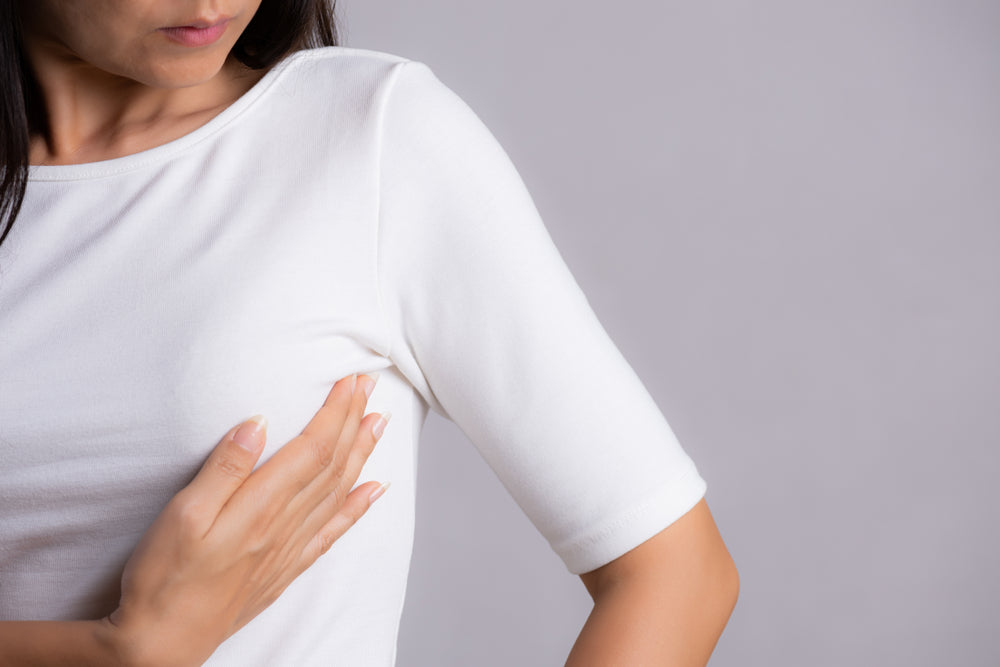Performing a Breast Exam on Yourself: A Few Tips

You’ve probably heard that it’s a good idea to “check yourself” regularly for breast abnormalities, but what exactly does that mean? And what should you be looking for?
The first thing you should know is that self-exams do not take the place of mammography because of their limitations in dense breasts and masses under one centimeter. While superficial masses smaller than one centimeter may be picked up by examination, the reliability has been questioned.
That said, a monthly self-breast exam is still a good idea (right after your period) because it can help you become familiar with what your breasts should feel like and help you feel comfortable picking up subtle changes. Nodular or lumpy breasts can be confusing, which makes early initiation of breast exams essential to detect future changes.
Why Are Breast Exams Important?
Breast cancer is a scary diagnosis, but early treatment can be lifesaving. Breast cancer is the second most common type of cancer in women, yet men can also get breast cancer. In fact, early studies on breast cancer were conducted on males. Despite the improvements in radiology and mammography technology, early detection of breast cancer is not always picked up with screening mammography.
Mammography has a sensitivity of about 85% to 90% in women older than 50 years of age and much less in women with dense breasts. For women between the ages of 40 and 50, sensitivity is about 75% and lower in women younger than age 40. One out of four breast cancers will be missed with these statistics.[3]
This fact underscores the importance of regular self-screening exams. In fact, 10-25% of breast cancers are picked up by self-breast exams that lead to a mammogram for confirmation. The good news is that any lumps picked up by exam are benign in 50-94% of cases. The most common benign findings are cysts or fibromas.
The use of mammograms before the age of 40 can lead to high false-positive rates, and the trend is now to begin mammograms at age 50. This means that self-breast exams are crucial under the age of 40. Any abnormalities or changes need to be immediately followed up with a mammogram, but if a mammogram is negative in the face of a new mass, additional study is needed.
How to Perform a Self Breast Exam
Observation
I recommend using a mirror for this. While sitting up and with your arms at your side, note the shape, skin, and color of your breasts. Skin retraction, ulceration, erythema, or crusting of the nipples, as well as whether the nipples are inverted, everted, or flat, should be documented.
Next, raise your arms above your head and observe for retraction or tethering of the tissue to the chest wall.
Palpation
While still sitting, use your finger pads to palpate, or massage all the tissue between the skin and the chest wall and under the armpit.
You can use a circular motion in each position from superficial to deep pressure, paying attention to the tissue at each level, moving in a clockwise, then counterclockwise fashion.
The optimal length of the exam is 1-2 minutes, with longer exams picking up more findings.
Self-exams can be easily performed in the shower using soap, which makes the exam easier to perform and creates less discomfort.
Conclusion
Early detection of breast cancer symptoms can be life-saving, which is why we’ve sought to demystify the self-exam process. So once a month, take some time to check yourself.
Understanding the way your breasts normally look and feel can enable you to confidently know when something is off, and potentially save your life.
References
- http://www.uspreventiveservicestaskforce.org/uspstf/uspsbrca.htm.
- Baines CJ, Miller AB, Bassett AA. Physical examination. Its role as a single screening modality in the Canadian National Breast Screening Study. Cancer. 1989 May 1. 63(9):1816-22.
- Kerlikowske K, Grady D, Barclay J, Sickles EA, Ernster VL. Effect of age, breast density and family history on the sensitivity of first screening mammography. JAMA. 1996;276:33-38.
- Breast Cancer Facts & Figures 2019-2020. American Cancer Society. Available at https://www.cancer.org/content/dam/cancer-org/research/cancer-facts-and-statistics/breast-cancer-facts-and-figures/breast-cancer-facts-and-figures-2019-2020.pdf. Accessed: March 12, 2020.
- Reeves GK, Beral V, Green J, Gathani T, Bull D; Million Women Study Collaborators. Hormonal therapy for menopause and breast-cancer risk by histological type: a cohort study and meta-analysis. Lancet Oncol. Nov 2006. 7(11):910-8.

Newsletter signup
Join the Joy Organics Family
Sign up and get updates on new products, as well as special coupons and discounts.
testimonials
What Our Clients Say
“This is a company that truly cares about its customers and providing the best CBD products currently available on the market.”









Join In On The Conversation
Your email address will not be published. Required fields are marked *
Comments will be approved before showing up.